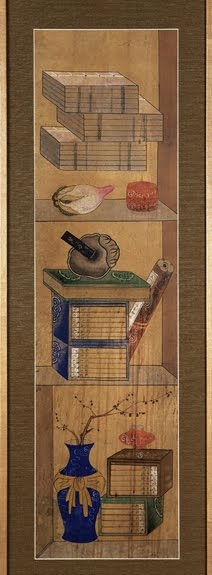Korean Folk Art: Minhwa Chaekgado
Every culture in history all over our planet has produced folk art, i.e. art intended for the everyday person, rather than wealthy or noble patrons. Although similar to so-called “primitive” art (a term against which I’ve railed in the past) the artists were often self-trained, folk artists differ from the other because they did not imitate art that was patronized by the wealthy; they produced subjects meant to be appreciated by every day people.
And unfortunately, unlike the artists popular with the upper classes, most Korean folk artists are not known by name. In Korea, minhwa is the term for folk art. Along with chaekgado (or ch'aekkori, literally "books and things"), popular subjects included hwajodo (flowers and birds), hojakdo (scenes inspired by popular fairy tales), and sansuhwa (scenery). Fortunately there are artists working in the traditional folk subject matter and style to this day.
 |
| Korea, Chaekgado (or Ch'aekkori) (Scholar’s Accoutrements), 1800s. Colors on paper, 39 3/16" x 10 11/16" (99.5 x 27.2 cm). © Museum of Fine Arts, Boston. (MFAB-1300) |
When we think of painting in Asia, we naturally immediately think of China and Japan. For centuries, however, Korea played a pivotal role in the region, transmitting culture between China and Japan (especially in the field of ceramics). Always influenced by Chinese art, after a thwarted Mongol invasion in the 1500s, Korea became a semi-independent state until it was invaded by Japan in 1910. During the 1700s, Chinese influence waned in Korea, and Korean painting came into its own. Everyday life and objects were one of the two most popular genres of Korean painting of the 1700s and 1800s, next to landscapes. Chaekgado is a late manifestation of the Joseon period (1392–1910).
This panel most likely comes from an eight-fold or ten-fold screen. Such screens were used by common people and nobility alike. The subject is the attributes of a scholar: books, paintings, ceramics, ink stones, pen containers, and musical instruments scattered in bookshelves. The subject itself is actually inspired by the reverence for scholars who esteemed learning and art above all else. This itself was a Chinese tradition, which nurtured the whole school of “literati painting” of scholar/artists. The subject would have appealed to both commoner and noble alike. While the objects are realistically portrayed, their placement within each shelf is somewhat mystical, as if some of them are actually floating. The perspective within each shelf is typical of Chinese and Japanese painting and prints at the time.
Minhwa suffered a decline in popularity in Korea after the Japanese invasion. Ironically, it was a Japanese collector who revived interest in the genre when he established the Japan Folk Crafts Museum in Tokyo in 1936 to display Korean art. This museum inspired Japanese collection of Korean folk art, to the point now where some of the most outstanding examples reside in Japanese collections. Two recent exhibits have helped to energize interest in minhwa among Koreans: “Happy! Joseon Folk Painting” in 2006 at the Seoul Museum of History, and “Korean Folk Paintings – Diversity and Creativity” (2006) at the National Folk Museum of Korea in Seoul.
Additional Resources:
The Art Institute of Chicago has a gorgeous chaekgado.
This example from the Virginia Museum of Fine Arts depicts objects not necessarily related to scholars.
Interesting interview with contemporary minhwa artist Kim Hye-joong from earlier this year.


Comments